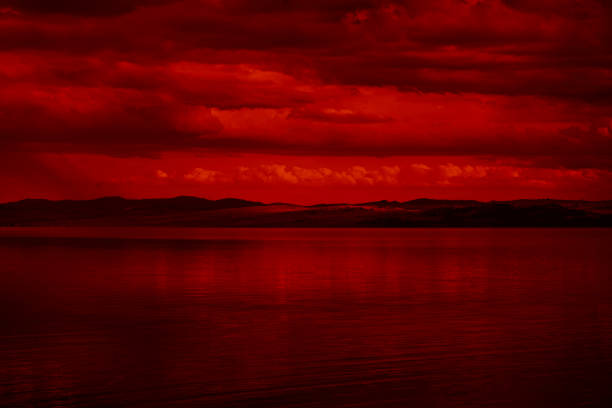Table of Contents
The Day of Solar Wrath
As the sun reached its zenith on Led 21st, 7524 SF, the sky burned red.

Every Cahyali citizen knows the story of the Day of Solar Wrath. Some see it as a great day of liberation, while others take it as a tragic day of destruction and mourning. Historians from the day recorded the events thoroughly, so records of it persist even into the modern era. Nearly every schoolkid will study this day at some point in their lives.
The most notable thing the Day of Solar Wrath is known for is killing 90% of Cahyali's elves, and leaving the survivors destitute and soulless. As many of these elves were citizens of the then-worldwide Dahabi Empire, so too did the empire fall, ending thousands of years of colonization. The cause of Solar Wrath is unknown, with scholars, priests, and mages remaining in endless debate.
Some believe it was caused by a runaway Dahabi experiment, causing a magic-boosting agent in Dahabi elves' bodies to catalyze and kill them. Others believe it was retribution from the gods, who had decreed the Empire should come to an end. Still others think it has some link with the Elvesbane plague of Jaernian history, as both had similar effects despite occurring almost four thousand years apart.
Events Throughout the Day
Zenith of the Red Sun
The day of Led 21 seemed normal until midday in the north. Those in Buyuk Vahsi and the Oxis Alliance noticed the change in the sky first. As the sun rose, the sky began to turn red and the sun darkened, almost like a solar eclipse - but there was no moon in the sky at the time. Any Dahabi citizen the red light touched died almost immediately, with many bursting spontaneously into green flames.
The Wrath Reaches Dahabu
In the north, the Day of Solar Wrath resulted in an uncomfortably hot day, but few fires in the environment happened. The green flames that burned on the flailing bodies of dying elves didn't spread, and other than anarchy and chaos the celestial event itself seemed to have little effect. This was the case for most nations.
However, Dahabu itself was not so lucky. The pyramids, cities, and lush forests caught aflame just like the citizens, and the land burned for nearly a week after the red sun first rose. When the fires eventually died out, Dahabu would be entirely scorched, with the River Aset dried to nothing. With the region about entirely desertified, it would not be inhabitable past coastal regions for two millennia.
Sunset
As the chaos of the day raged on and passed, twilight eventually came. Reports attest that the souls of dead elves congregated into massive ethereal storms, flying about the bright moon Dipha and eventually dispersing into the sky. From there, the sun rose normally the next morning… and every morning after.
The Aftermath
Milphite crystals are thought by some superstitious folks to be the crystallized souls of elves who perished in the calamity and were unable, one way or another, to escape into the storms seen at sunset on that day. Some doubt this theory. One way or another, though, the immense potential power of milphite seems to have something to do with the Day of Solar Wrath, as it is found most commonly in the sands of Dahabu, and only appeared after the Empire's fall.
With 90% of its citizens burnt to ashes, the Dahabi Empire had no feet to stand on. In most places, it was overthrown in a matter of months, with the nations' civilizations finally allowed to flourish free of colonization. Undoubtedly, the Day of Solar Wrath is the most pivotal single day in all of Cahyali history, which is why the Solar Calendar of Cahyali uses the date of this event as an epoch event, resetting the calendar. This system of date counting is popular among many of the common people of Cahyali.
The Cause
There is no theory as to the Day of Solar Wrath's cause that is widely accepted among most scholars. However, there are a few prevailing theories believed by different people, each with their own pieces of evidence and holes that don't add up.
Divine Wrath
Many Jaernians who hear about this event make the immediate assumption that the Day of Solar Wrath was a simple act of divine intervention, most likely a large-scale smite from a god such as Ra, or perhaps Almar.
After all, little but a god could bring destruction with this specificity and on such a scale. However, high veneration of the gods was common and sometimes mandatory within the Dahabi Empire, so scholars debate on why exactly their ire would have been attracted by the Empire's actions.
Experiment Gone Wrong
Some scholars in the Abundant Expanse and Sublime Veld investigate why the deaths only struck Dahabi citizens, concluding that they may have taken some soul-affecting substance to enhance their magic. On the Day, some experiment from Dahabu rippled through Cahyali's leylines, striking any person with that substance - mostly Dahabi, killing them.
Leylines are known to be an effective conduit for all types of magical energy, even being harnessed for long-distance communications in the modern day. However, this theory lends no explanation as to why the appearance of the sun was affected, and why the sun's light seemed to be the catalyst for death.
Demonic Influence
Learned demonologists point out the similarity of the green flames which burned on the victims to the Fel Flame of the Beneath, a power source for that hellish land that is known for burning everything it touches and being a death sentence to mortals.
They believe that a strong demonic contract may have been responsible for the event, as a way for the patron to harvest souls. However, this doesn't explain why the souls of Solar Wrath's victims appear to remain trapped in milphite crystals to this day.